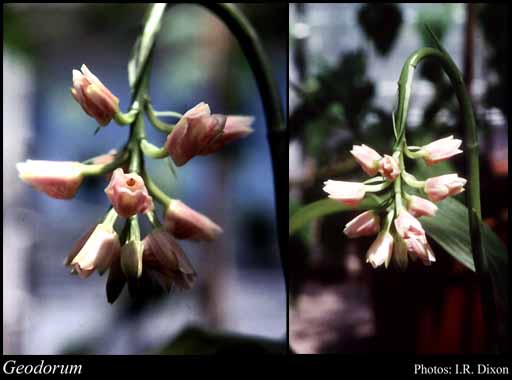This name is not current. Find out more information on related names.
- Reference
- Bot.Repos. 10(128-131): Pl. 626 (1811)
- Name Status
- Not Current







Scientific Description
Family Orchidaceae.
Habit and leaf form. Herbs; deciduous. Perennial. Leaves cauline (borne at the end of a short stem which later swells at the base to form a pseudobulb, the largest leaf uppermost). With rounded, more or less subterranean pseudobulbs. Helophytic, or mesophytic. Leaves medium-sized to very large; alternate, or opposite, or whorled; ‘herbaceous’, or leathery; imbricate, or not imbricate; petiolate; simple; jointed at the base of the blade. Leaf blades entire; flat; broad; parallel-veined; cross-venulate, or without cross-venules; attenuate at the base. Leaf blade margins entire. Vernation plicate. Stem anatomy. Secondary thickening absent.
Reproductive type, pollination. Fertile flowers hermaphrodite. Unisexual flowers absent. Plants hermaphrodite. Entomophilous (small native bees). Pollination mechanism conspicuously specialized.
Inflorescence and flower features. Flowers aggregated in ‘inflorescences’; in spikes. The terminal inflorescence unit racemose. Inflorescences scapiflorous, or not scapiflorous; terminal; separate from leaf-bearing stalk, erect, the flowers crowded on a short, nodding rachis that later straightens prior to seed dispersal. Flowers small to medium-sized; fragrant, or odourless; very irregular; zygomorphic; resupinate. The floral asymmetry involving the perianth and involving the androecium. Flowers 3 merous; cyclic; supposedly basically pentacyclic. Perigone tube absent. Perianth of ‘tepals’, or with distinct calyx and corolla; 6; 2 -whorled; isomerous (but zygomorphic); free (although appearing tubular); pink to purple (in G. neocaledonicum). Calyx (if the outer whorl be so designated) 3 (the median member ostensibly posterior); 1 -whorled; polysepalous. Corolla (i.e. the members of the inner whorl) 3; polypetalous; imbricate. Androecium 3, or 1 (by misinterpretation). Androecial members free of the perianth; united with the gynoecium (fused with the style to form a column or ‘gynostemium’); coherent (via the gynostemium); 1 - adelphous; theoretically 2 -whorled. Androecium including staminodes, or exclusively of fertile stamens (by misinterpretation). Staminodes 2 (these anterior (ostensibly posterior), supposedly the abaxial pair of the inner whorl). Stamens 1 (this across the flower from the labellum, i.e. anterior but ostensibly posterior, supposedly representing the outer whorl); reduced in number relative to the adjacent perianth; alterniperianthial (i.e. with reference to the single stamen, across the flower from the labellum); filantherous, or with sessile anthers. Anthers dorsifixed to basifixed; dehiscing via longitudinal slits; introrse; tetrasporangiate; appendaged, or unappendaged. Pollen shed in aggregates; in the form of pollinia (pollinia 2, grooved or with a cavity, joined by a short stipe to the well-developed retinaculum). Gynoecium 3 carpelled. The pistil 1 celled. Carpels isomerous with the perianth. Gynoecium syncarpous; eu-syncarpous; inferior. Ovary unilocular; 1 locular. The ‘odd’ carpel anterior (away from the labellum). Gynoecium stylate. Styles 1 (inflexed); apical. Stigmas 1; 3 - lobed (but becoming much modified in form, the apex of the median lobe forming the ‘rostellum’); wet type; papillate; Group III type. Placentation parietal. Ovules not differentiated; in the single cavity 30–100 (i.e. very numerous); non-arillate; anatropous.
Fruit and seed features. Fruit non-fleshy; dehiscent; a capsule. Capsules septicidal, or loculicidal. Fruit 30–500 seeded (i.e. seeds usually very numerous). Seeds endospermic (endosperm development arrested very early), or non-endospermic; minute; without starch. Embryo rudimentary at the time of seed release, or weakly differentiated. Seedling. Seedling collar not conspicuous. Primary root ephemeral.
Geography, cytology, number of species. Native of Australia. Not endemic to Australia. Australian states and territories: Western Australia, Northern Territory, Queensland, and New South Wales. Northern Botanical Province.
Additional characters Perianth of 5 similar members and the median inner member modified into the labellum (sepals and lateral petals almost equal, petals often slightly broader than sepals; labellum sessile on a short, distinct column foot and forming with it a saccate base, obscurely lobed; lateral lobes erect and close to the column). Leaves not solitary (several). Leaves erect. Labellum not insect-like. Labellum not motile. Perianth not glossy.
Taxonomic Literature
- Wheeler, J. R.; Rye, B. L.; Koch, B. L.; Wilson, A. J. G.; Western Australian Herbarium 1992. Flora of the Kimberley region. Western Australian Herbarium.. Como, W.A..